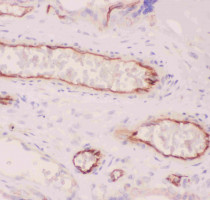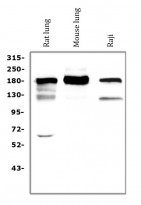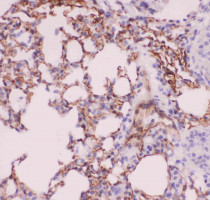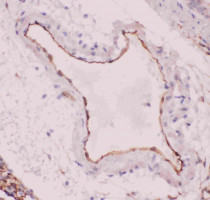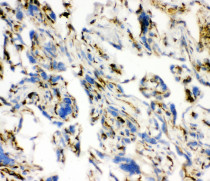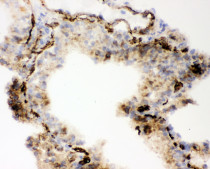ARG41098
anti-ACE antibody
anti-ACE antibody for ICC/IF,IHC-Frozen sections,IHC-Formalin-fixed paraffin-embedded sections,Western blot and Human,Mouse,Rat
Overview
| Product Description | Rabbit Polyclonal antibody recognizes ACE |
|---|---|
| Tested Reactivity | Hu, Ms, Rat |
| Tested Application | ICC/IF, IHC-Fr, IHC-P, WB |
| Host | Rabbit |
| Clonality | Polyclonal |
| Isotype | IgG |
| Target Name | ACE |
| Antigen Species | Human |
| Immunogen | Recombinant protein corresponding to K651-Y864 Human ACE. |
| Conjugation | Un-conjugated |
| Alternate Names | DCP1; ICH; ACE; EC 3.2.1.-; MVCD3; Angiotensin-converting enzyme; Dipeptidyl carboxypeptidase I; CD143; CD antigen CD143; EC 3.4.15.1; Kininase II; ACE1; DCP |
Application Instructions
| Application Suggestion |
|
||||||||||
|---|---|---|---|---|---|---|---|---|---|---|---|
| Application Note | IHC-P: Antigen Retrieval: Heat mediation was performed in Citrate buffer (pH 6.0) for 20 min. * The dilutions indicate recommended starting dilutions and the optimal dilutions or concentrations should be determined by the scientist. |
||||||||||
| Observed Size | ~ 180 kDa |
Properties
| Form | Liquid |
|---|---|
| Purification | Affinity purification with immunogen. |
| Buffer | 0.2% Na2HPO4, 0.9% NaCl, 0.05% Sodium azide and 5% BSA. |
| Preservative | 0.05% Sodium azide |
| Stabilizer | 5% BSA |
| Concentration | 0.5 mg/ml |
| Storage Instruction | For continuous use, store undiluted antibody at 2-8°C for up to a week. For long-term storage, aliquot and store at -20°C or below. Storage in frost free freezers is not recommended. Avoid repeated freeze/thaw cycles. Suggest spin the vial prior to opening. The antibody solution should be gently mixed before use. |
| Note | For laboratory research only, not for drug, diagnostic or other use. |
Bioinformation
| Database Links | |
|---|---|
| Gene Symbol | ACE |
| Gene Full Name | angiotensin I converting enzyme |
| Background | This gene encodes an enzyme involved in catalyzing the conversion of angiotensin I into a physiologically active peptide angiotensin II. Angiotensin II is a potent vasopressor and aldosterone-stimulating peptide that controls blood pressure and fluid-electrolyte balance. This enzyme plays a key role in the renin-angiotensin system. Many studies have associated the presence or absence of a 287 bp Alu repeat element in this gene with the levels of circulating enzyme or cardiovascular pathophysiologies. Multiple alternatively spliced transcript variants encoding different isoforms have been identified, and two most abundant spliced variants encode the somatic form and the testicular form, respectively, that are equally active. [provided by RefSeq, May 2010] |
| Function | Converts angiotensin I to angiotensin II by release of the terminal His-Leu, this results in an increase of the vasoconstrictor activity of angiotensin. Also able to inactivate bradykinin, a potent vasodilator. Has also a glycosidase activity which releases GPI-anchored proteins from the membrane by cleaving the mannose linkage in the GPI moiety. [UniProt] |
| Cellular Localization | Angiotensin-converting enzyme, soluble form: Secreted. Cell membrane; Single-pass type I membrane protein. Cytoplasm. Note=Detected in both cell membrane and cytoplasm in neurons. [UniProt] |
| Calculated MW | 150 kDa |
| PTM | Phosphorylated by CK2 on Ser-1299; which allows membrane retention. [UniProt] |
Images (8) Click the Picture to Zoom In
-
ARG41098 anti-ACE antibody ICC/IF image
Immunofluorescence: A431 cells were blocked with 10% goat serum and then stained with ARG41098 anti-ACE antibody (green) at 2 µg/ml dilution, overnight at 4°C. DAPI (blue) for nuclear staining.
-
ARG41098 anti-ACE antibody IHC-P image
Immunohistochemistry: Paraffin-embedded Human placenta tissue. Antigen Retrieval: Heat mediation was performed in Citrate buffer (pH 6.0, epitope retrieval solution) for 20 min. The tissue section was blocked with 10% goat serum. The tissue section was then stained with ARG41098 anti-ACE antibody at 1 µg/ml, overnight at 4°C.
-
ARG41098 anti-ACE antibody WB image
Western blot: 50 µg of samples under reducing conditions. Rat lung, Mouse lung and Raji whole cell lysates stained with ARG41098 anti-ACE antibody at 0.5 µg/ml, overnight at 4°C.
-
ARG41098 anti-ACE antibody IHC-P image
Immunohistochemistry: Paraffin-embedded Mouse lung tissue. Antigen Retrieval: Heat mediation was performed in Citrate buffer (pH 6.0, epitope retrieval solution) for 20 min. The tissue section was blocked with 10% goat serum. The tissue section was then stained with ARG41098 anti-ACE antibody at 1 µg/ml, overnight at 4°C.
-
ARG41098 anti-ACE antibody IHC-P image
Immunohistochemistry: Paraffin-embedded Rat lung tissue. Antigen Retrieval: Heat mediation was performed in Citrate buffer (pH 6.0, epitope retrieval solution) for 20 min. The tissue section was blocked with 10% goat serum. The tissue section was then stained with ARG41098 anti-ACE antibody at 1 µg/ml, overnight at 4°C.
-
ARG41098 anti-ACE antibody IHC-P image
Immunohistochemistry: Paraffin-embedded Rat lung tissue. Antigen Retrieval: Heat mediation was performed in Citrate buffer (pH 6.0, epitope retrieval solution) for 20 min. The tissue section was blocked with 10% goat serum. The tissue section was then stained with ARG41098 anti-ACE antibody at 1 µg/ml, overnight at 4°C.
-
ARG41098 anti-ACE antibody IHC-Fr image
Immunohistochemistry: Frozen section of Human placenta tissue. The tissue section was blocked with 10% goat serum. The tissue section was then stained with ARG41098 anti-ACE antibody at 1 μg/ml dilution, overnight at 4°C.
-
ARG41098 anti-ACE antibody IHC-Fr image
Immunohistochemistry: Frozen section of Mouse lung tissue. The tissue section was blocked with 10% goat serum. The tissue section was then stained with ARG41098 anti-ACE antibody at 1 μg/ml dilution, overnight at 4°C.

